Teams often add foam rolling and massage guns to pre-practice warm-ups.
Coaches and athletes assume these tools boost readiness, mobility, and power.
And while that may be true, timing is critical for these tools.
This study investigated whether incorporating foam rolling or a massage gun after a dynamic warm-up enhances immediate performance in trained team-sport athletes.
Does adding foam rolling or a massage gun after a dynamic warmup help or hurt jumping, sprinting, and ankle mobility?
Master Performance Coaching & Elevate Your Career in Just 6 Weeks with a Global Community of Professionals
What Did the Researchers Do?
Study Design
- Researchers used a randomized, counterbalanced crossover. Each athlete completed three sessions separated by at least 48 hours:
- Dynamic warm-up only (CON)
- Dynamic warm-up + foam rolling (FOAM)
- Dynamic warm-up + massage gun (GUN)
Participants
- 16 trained athletes (age ~23; 12 male, 4 female) from Australian rules football, basketball, netball, and soccer. All had ≥3 years of strength training.
Interventions
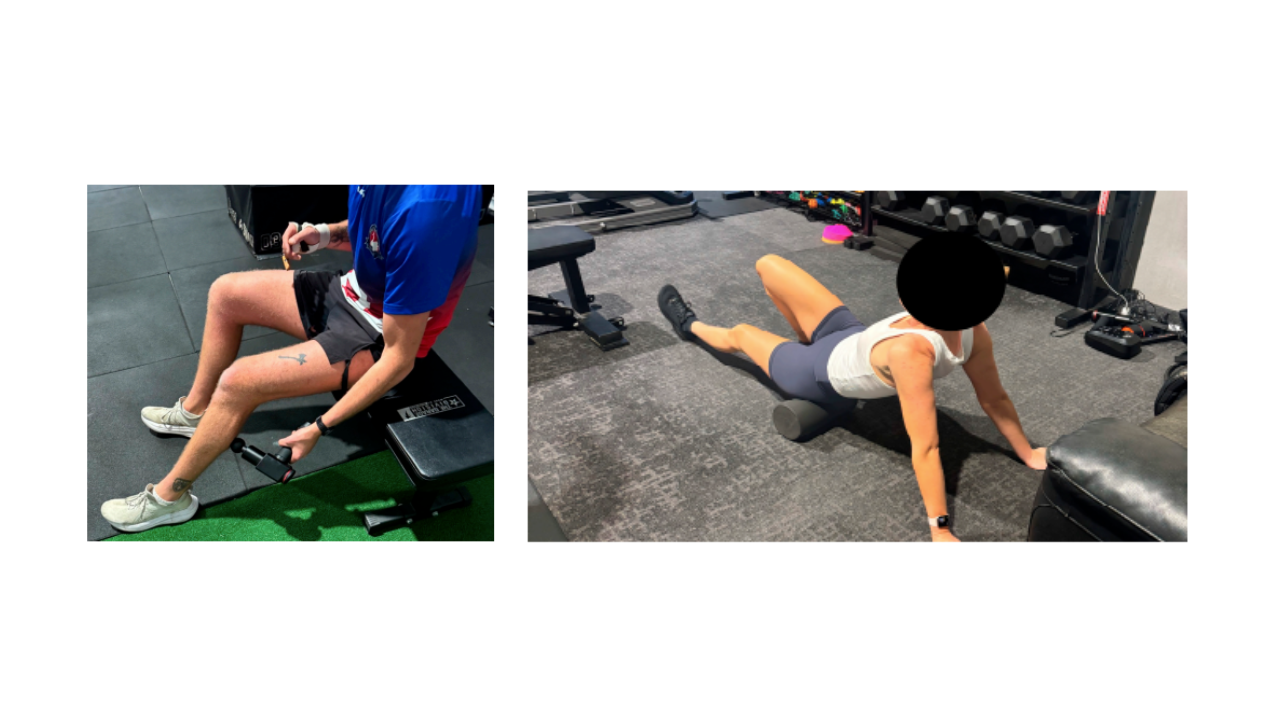
- FOAM: 12 minutes total (6 min per leg) on quads, hamstrings, calves using a high-density EVA roller at ~25% bodyweight pressure.
- GUN: 12 minutes total (6 min per leg) on the same muscles with a Hydragun at ~53 Hz using a soft ball head.
- All sessions began with the same RAMP-style dynamic warm-up.
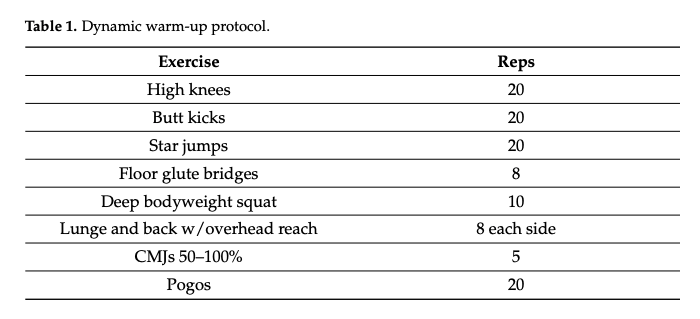
Outcomes (Post Warm-Up)
- Countermovement Jump (CMJ) height and RSImod on VALD ForceDecks
- 10/5 repeated jump test (RJT) metrics
- 20 m sprint with timing gates
- Knee-to-wall ankle dorsiflexion
- Perceived soreness and fatigue (1–5 Likert)

What Were the Results?

Jump performance down after tools
- CMJ height decreased after both GUN and FOAM vs control (small effects, d ≈ −0.36 and −0.29).
- CMJ RSImod decreased after both GUN and FOAM vs control (d ≈ −0.52 and −0.40).

Sprint speed is impaired with the gun
- 20 m sprint was slower after GUN vs control (d ≈ 0.34).
- FOAM did not differ from control.
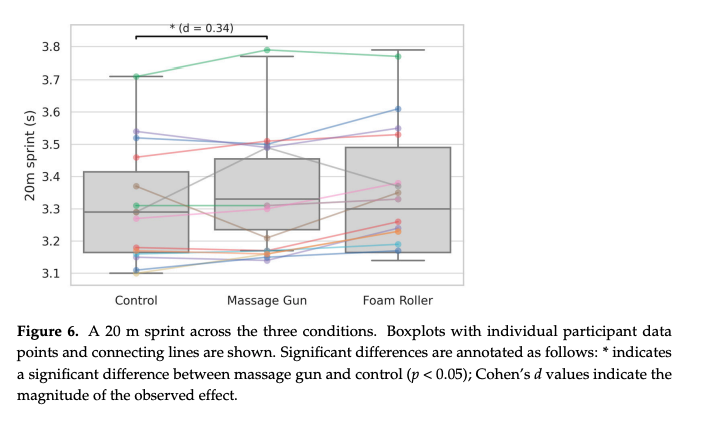
Reactive strength unchanged
- 10/5 RJT RSI, contact time, and flight time showed no significant differences across conditions.
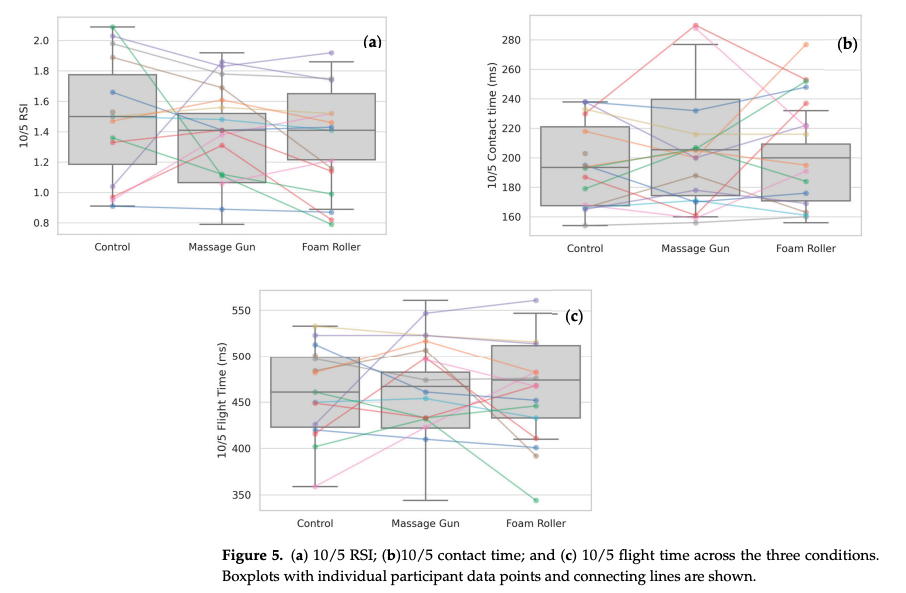
Mobility and soreness
- Left ankle dorsiflexion improved slightly after FOAM vs control (small effect).
- Perceived muscle soreness scores were better after FOAM vs control.
- Fatigue scores were similar across conditions.
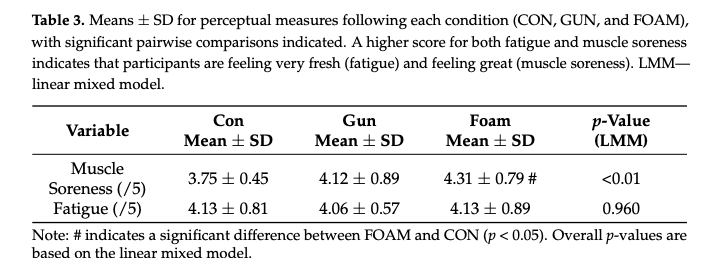
What Does This Mean?
- When a solid dynamic warm-up is already in place, adding foam rolling or a massage gun right before testing or training can blunt explosive outputs like CMJ height and RSImod.
- Massage guns may slow sprint performance.
- Foam rolling may offer small benefits in ankle mobility and perceived soreness, but not enough to offset the drop in jump metrics in this context.
Important Limitations
- Order of activities: All participants performed a dynamic warm-up first, then added 12 minutes of foam rolling or massage gun use before testing. This sequencing may have allowed the physiological benefits of the dynamic warm-up (elevated temperature, neural activation, potentiation) to decay, potentially explaining the lower jump and sprint outcomes.
- Passive vs. active time: Foam rolling and massage gunning are relatively passive compared to dynamic drills. Spending this much time in low-intensity activity may reduce readiness, independent of the direct effects of the tools themselves.
This data is not evidence that these tools do not work but rather that using these tools after a dynamic warmup and prior to testing may decrease performance. If you are going to use these tools, opt for prior to warming up and / or post training recovery.
Coach’s Takeaway
- Keep the dynamic warm-up as the star.
- Avoid massage guns in the final minutes before sprints and jumps.
- Use foam rolling earlier in the prep or during recovery if soreness relief or small ROM gains are the goal.
I hope this helps,
Ramsey
Reference
Ormeno L, Driller M. (2025). Does Massage Gun or Foam Roller Use During a Warm-Up Improve Performance in Trained Athletes? Sports, 13:282. DOI: 10.3390/sports13090282.




